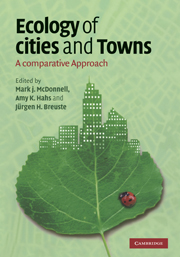Book contents
- Frontmatter
- Contents
- List of contributors
- Preface
- 1 Introduction: Scope of the book and need for developing a comparative approach to the ecological study of cities and towns
- Part I Opportunities and challenges of conducting comparative studies
- Part II Ecological studies of cities and towns
- 8 Responses of faunal assemblages to urbanisation: global research paradigms and an avian case study
- 9 Effect of urban structures on diversity of marine species
- 10 Comparative studies of terrestrial vertebrates in urban areas
- 11 The ecology of roads in urban and urbanising landscapes
- 12 Spatial pattern and process in urban animal communities
- 13 Invertebrate biodiversity in urban landscapes: assessing remnant habitat and its restoration
- 14 Arthropods in urban ecosystems: community patterns as functions of anthropogenic land use
- 15 Light pollution and the impact of artificial night lighting on insects
- 16 A comparison of vegetation cover in Beijing and Shanghai: a remote sensing approach
- 17 Vegetation composition and structure of forest patches along urban–rural gradients
- 18 Environmental, social and spatial determinants of urban arboreal character in Auckland, New Zealand
- 19 Carbon and nitrogen cycling in soils of remnant forests along urban–rural gradients: case studies in the New York metropolitan area and Louisville, Kentucky
- 20 Investigative approaches to urban biogeochemical cycles: New York metropolitan area and Baltimore as case studies
- Part III Integrating science with management and planning
- Part IV Comments and synthesis
- References
- Index
- Plate section
10 - Comparative studies of terrestrial vertebrates in urban areas
Published online by Cambridge University Press: 04 March 2010
- Frontmatter
- Contents
- List of contributors
- Preface
- 1 Introduction: Scope of the book and need for developing a comparative approach to the ecological study of cities and towns
- Part I Opportunities and challenges of conducting comparative studies
- Part II Ecological studies of cities and towns
- 8 Responses of faunal assemblages to urbanisation: global research paradigms and an avian case study
- 9 Effect of urban structures on diversity of marine species
- 10 Comparative studies of terrestrial vertebrates in urban areas
- 11 The ecology of roads in urban and urbanising landscapes
- 12 Spatial pattern and process in urban animal communities
- 13 Invertebrate biodiversity in urban landscapes: assessing remnant habitat and its restoration
- 14 Arthropods in urban ecosystems: community patterns as functions of anthropogenic land use
- 15 Light pollution and the impact of artificial night lighting on insects
- 16 A comparison of vegetation cover in Beijing and Shanghai: a remote sensing approach
- 17 Vegetation composition and structure of forest patches along urban–rural gradients
- 18 Environmental, social and spatial determinants of urban arboreal character in Auckland, New Zealand
- 19 Carbon and nitrogen cycling in soils of remnant forests along urban–rural gradients: case studies in the New York metropolitan area and Louisville, Kentucky
- 20 Investigative approaches to urban biogeochemical cycles: New York metropolitan area and Baltimore as case studies
- Part III Integrating science with management and planning
- Part IV Comments and synthesis
- References
- Index
- Plate section
Summary
Introduction
Comparative studies of terrestrial vertebrates are one approach that can be used by researchers to build on the extensive work done by animal ecologists and applied ecologists in cities (Luniak, 1990; VanDruff et al., 1994; Nilon and Pais, 1997). Much of this work pre-dates the renewed interest in cities by mainstream ecologists. The new emphasis on the ecology of cities provides new tools and approaches to conducting comparative studies that will be useful in answering questions about vertebrates in cities. In this chapter I will discuss why comparative studies of vertebrates are important to ecologists, managers and people who live in cities by reviewing the comparative studies that have been done on the vertebrate fauna of cities. I will describe some of the research on vertebrates that occurs within the framework of urban ecosystems research, and I will propose a comparative study that illustrates how contemporary approaches to urban ecology can be applied to a conservation issue.
Comparative studies ask and answer questions about the ecology of cities
The need for comparative studies comes from a need to answer questions about animals in cities. The questions are shaped by different groups (i.e. scientists, the public, resource managers, policy makers and conservationists) that care about animals in cities. Traditional ecologists studying cities ask questions about ecosystem structure and function.
- Type
- Chapter
- Information
- Ecology of Cities and TownsA Comparative Approach, pp. 177 - 184Publisher: Cambridge University PressPrint publication year: 2009
- 3
- Cited by

